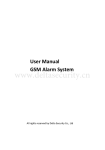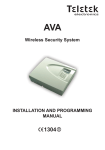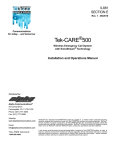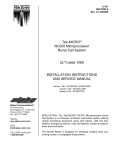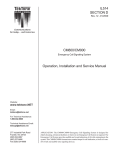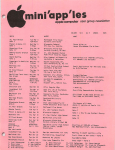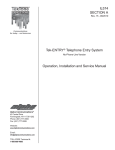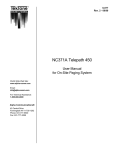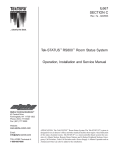Download with PK400 - Alpha Communications
Transcript
IL603 SECTION B Rev. 6 - 05/2004 Tek-COM® SM400 Multi-Master and Master/Remote Intercom Systems Operation, Installation and Service Manual Alpha Communications® 42 Central Drive Farmingdale, NY 11735-1202 Phone: (631) 777-5500 Fax: (631) 777-5599 Website: www.alpha-comm.com Email: [email protected] TOLL-FREE Technical #: 1-800-666-4800 The Tek-COM® SM401, SM404, SM406 and SM411 intercoms provide for masterto-master, master-to-remote and intermixed operation suitable for offices, homes, warehouses and any areas where quick, convenient loudspeaking communication is needed. Multicolored signal lights, hands-free reply, privacy and monitoring are all standard features. Optional equipment is available to call all stations, distribute music, and control remote devices. Operation, Installation and Service Manual Copyright © 2001–2003 TekTone® Sound & Signal Mfg., Inc., All rights reserved. No part of this publication may be copied without the express written permission of TekTone® Sound & Signal Mfg., Inc. The content of this manual is furnished for informational use only, is subject to change without notice, and should not be construed as a commitment by TekTone® Sound & Signal Mfg., Inc. TekTone® Sound & Signal Mfg., Inc. assumes no responsibility or liability for any errors or inaccuracies that may appear in this documentation. TekTone, the TekTone logo, Tek-Call, Tek-Care, Tek-Check-In, Tek-Com, Tek-Digicare, Tek-Door, Tek-Entry III, Tek-Guard, TekMicro, Tek-Micro II, Tek-MMARS II, TekNIOS, TekNIOS II, Tek-Paging, Tek-Phone, Tek-Safe, Tek-Select II, Tek-Sentry, TekSound, Tek-Status, Tek-Trio and Tek-View are either registered trademarks or trademarks of TekTone® Sound & Signal Mfg., Inc. in the United States and/or other countries. All other trademarks are the property of their respective owners. ii • IL603 Tek-COM® SM400 Manual Table of Contents ———————————————————— System Operating Instructions .............................................................. 1 Master Station .............................................................................................................. 1 Call another station ............................................................................................... 1 Answer a call from a master at a remote .............................................................. 1 Answer a call from a master at a master ............................................................... 1 Open the door (if installed) .................................................................................. 1 Page all stations (if installed) ............................................................................... 1 Monitor a room .................................................................................................... 2 Remote Station ............................................................................................................ 2 Call a master ......................................................................................................... 2 System Installation ................................................................................. 3 Installation Procedure .................................................................................................. 3 Planning and Equipment Location .............................................................................. 3 Masters and Remotes ........................................................................................... 3 Power Supply and Relays ..................................................................................... 3 Transformer .......................................................................................................... 3 Music System ....................................................................................................... 3 System Housings ......................................................................................................... 3 Wiring Installation ....................................................................................................... 4 Master Stations ..................................................................................................... 4 All Call ............................................................................................................... 4 Background Music ............................................................................................... 4 Door Release ........................................................................................................ 4 Remote to Master Cable ....................................................................................... 5 Paging Horn ......................................................................................................... 5 Connections ............................................................................................................... 5 Equipment Installation ................................................................................................. 5 Surface Mounting SM404, SM406 and SM411 Masters ..................................... 5 Flush Mounting SM404, SM406 and SM411 Masters ......................................... 5 Name Directory for SM404, SM406 and SM411 Masters ................................... 5 SM401 Master and Remote Stations .................................................................... 5 SM404, SM406 and SM411 Masters ................................................................... 6 SM400 Series Installation Instructions ........................................................................ 6 Factory Dip Switch Settings ........................................................................................ 6 Call Tone Volume Adjustment ............................................................................. 6 Terminal Reference for Master .................................................................................... 7 Connector 1 .......................................................................................................... 7 Connector 2 .......................................................................................................... 7 Connector 3 .......................................................................................................... 7 Illustrations & Wiring Diagrams Figure 1—Master Station Controls and Functions ..................................................... iv Figure 2—System and Options ................................................................................... iv Figure 3—SM406/SM411 Terminal IDs ..................................................................... 8 Figure 4—SM401 Terminal IDs .................................................................................. 8 Figure 5—PK400/RY400 Series Terminal IDs ........................................................... 8 Figure 6—SM411 Master to Master Wiring Diagram ................................................. 9 Figure 7—SM411 Intermix Wiring Diagram .............................................................. 9 Figure 8—SM406 Master to Master Wiring Diagram .............................................. 10 Figure 9—SM406 Master to Remote Wiring Diagram ............................................. 10 Figure 10—SM406/RY400 Wiring Diagram ............................................................ 11 Figure 11—SM406/RY402 Wiring Diagram ............................................................ 11 Figure 12—SM401 Wiring Diagram ......................................................................... 12 Figure 13—RY401 and RY402 Application with SM404 Master ............................ 12 IL603 Tek-COM® SM400 Manual • iii Figure 1 — Master Station Controls and Functions SM401 CALL 1. 2. 3. 4. 5. 6. 7. 8. SM404, SM406, SM411 STATION Speaker/Microphone Station Directory (SM404/6/11) Selector Button Talk LED Talk Button Monitor LED (SM404/6/11) Monitor Switch (SM404/6/11) Privacy LED 9. 10. 11. 12. 13. 14. 15. 16. Privacy Switch Door Release Button Music Volume Control Voice Volume Control Paging Switch (All Call) Paging LED Station Selector Switch LED Call Tone Button (SM401) Figure 2 — System and Options IR100B Indoor remote with no call capability PO001 Door strike IR510B Indoor remote with call button RY400 Remote control relay, 3 outputs IR141P Indoor remote with call button and privacy switch RY401 All-call relay for 12 stations RY402 In-use adapter IR141U Indoor remote with call button and in-use light (requires RY402 in-use adapter) SB205A Paging horn (requires EC105 capacitor and transformer) IR143P Indoor remote with 3 call buttons and privacy switch SF400 Call button for use with paging horn SM401 Master 2 station with background music, slide volume, all-call, one LED SM404 Master 5 station, with background music, slide volume, all-call, four LEDs SM406 Master 7 station, same as SM404 with 6 LEDs and selector switches SM411 Master 12 station, same as SM404 with 11 LEDs and selector switches SS106 Transformer OR541U Outdoor remote with call button and in-use light (requires RY402 in-use adapter) OR601 Outdoor remote with no call capability OR610 Outdoor remote with call button OR642 Outdoor remote with illuminated call button (walnut finish) OR642W Outdoor remote with illuminated call button (white finish) PK400 Power supply iv • IL603 Tek-COM® SM400 Manual System Operating Instructions —————————————— Master Station Call another station: If the TALK light is not illuminated red, select the desired station by pressing its associated selector button. The following will occur: • • • • • • The TALK light will illuminate yellow. The selected station CALL light will illuminate red. If the called station is non-private, sound from the called station will be heard. Set volume as needed. Press the TALK button to speak, release to listen. When finished, press the selected station button again to extinguish the CALL and TALK lights. Note: If a station button is pressed while the TALK light is red, the called station will not be connected. Press the selector button again to release it, and wait until the TALK light goes out. If the station is left selected, it will be connected when the system is free, but this may result in an undesirable howling noise if more than one master was waiting for the system to be free. Answer a call from a remote at a master: The incoming call will be announced by a chime or tone, and by a green CALL light. If the TALK light is not illuminated red, press the selector button associated with the illuminated CALL light. The following will occur: • • • • • The TALK light will illuminate yellow. The selected station CALL light will change from green to red. If the called station is non-private, sound from the calling station will be heard. Press the TALK button to speak, release to listen. When finished, press the selected station button again to extinguish the CALL and TALK lights. Note: If the station button is pressed while the TALK light is red, the selected station will not be connected. Press the selector button again to release it, and wait until the TALK light goes out. Answer a call from a master at a master: Calls from masters are not indicated by a light, but may be preceded by a short tone signal. Master calls are announced by voice. To answer, if the PRIVACY light is illuminated, press the PRIVACY button to turn privacy off. It is not necessary to operate any other controls. Reply by voice. Open the door (if installed): Press the DOOR button (identified by a key). Page all stations (if installed): If the TALK light is not illuminated red, press the PAGE switch to the right. The following will occur: • • • • • The TALK light will illuminate yellow. The PAGE light will illuminate yellow. If “talk back” is enabled, sounds from called stations will be heard. Press the TALK button to speak, release to listen. When finished, press the PAGE switch to the left to extinguish the TALK and PAGE lights. IL603 Tek-COM® SM400 Manual • 1 System Operating Instructions Monitor a room: If the MONITOR light is not illuminated red, press the MONITOR button, and then press the button associated with the desired station. The following will occur: • • • • The MONITOR light will illuminate yellow. The MONITOR light associated with the selected station will illuminate red. If the monitored station is non-private, sounds from that station will be heard. Set volume as needed. When the intercom is in use by another station, the monitoring will be interrupted, but will return when the other station is finished. When finished monitoring, press the selected station button and the MONITOR button to extinguish the MONITOR and CALL lights. Note: Do not attempt to use the MONITOR function if the MONITOR light is red. To do so may result in a loud noise from the intercom. Remote Station Call a master: If only one CALL button is available, press the button. If there is more than one CALL button, press the button to call the desired master. If the remote has a PRIVACY switch, and if privacy is selected, press the PRIVACY button to turn the privacy off. Reply by voice when spoken to. 2 • IL603 Tek-COM® SM400 Manual System Installation ——————————————————— Installation Procedure 1. 2. 3. 4. 5. Read instructions to determine equipment location and installation method. Install housings and wiring. Check and connect wiring. Program masters and install stations. Check operation. Planning and Equipment Location NOTE: Do not locate any intercom components or wiring within 3 feet (1 meter) of motors, transformers, fluorescent lights, dimmer switches, electrical wiring or other sources of electrical interference. NOTE: It is recommended that special consideration be given to the system cabling if electromagnetic interference (EMI) or radio frequency interference (RFI) presents a potential interference problem at a jobsite. The system cabling should be shielded—or in extreme cases installed in metallic conduit—to provide protection from extraneous signals or noise. If EMI (AC hum, ESD, computer or telephone data noise, etc.) and RFI interference sources are in physical contact (for example, intercom cable is placed on top of AC wiring), then standard shielded cable protection may be negated. NOTE: TekTone® is not responsible for interference resulting from improper installation. Masters and Remotes: Do not locate masters near any source of direct heat, extreme cold, or in areas exposed to dust, oil, chemicals or excess humidity. Locate stations where they will be convenient to use. If wall mounted, locate at convenient operating height. Do not locate stations close to each other (separate rooms are preferred). Do not locate flush mounted stations back to back on a common wall. Power Supply and Relays: Locate the power supply and other central equipment near the center of the master-tomaster cable run and where convenient for service. Do not locate units near any source of direct heat or extreme cold. Transformer: The transformer must be provided with 115 VAC electrical power. Locate the transformer within 50 feet (15 meters) of the power supply, and at least 3 feet (1 meter) from master stations, remote stations and intercom wiring. Do not locate transformers near any source of heat. Do not connect transformer to power source until wiring is complete. Observe all local and national electrical codes. Music System: Locate music system according to the instructions supplied with the system. If any area requires music without intercom, the music system may be located in that area. System Housings IH102 IH110R IH400A IH401 Flush mounting ring for indoor remotes Flush mounting ring for SM406 and SM411 masters Desk cabinet for SM401 and indoor remotes Desk cabinet for SM404, SM406 and SM411 IL603 Tek-COM® SM400 Manual • 3 System Installation Wiring Installation Master Stations: Master stations may be loop wired. Note: Due to common impedance coupling, tone signals may be amplified and heard by master stations monitoring other stations. With long wires, this interference may be quite loud. This effect may be reduced by using two conductors for the terminal C wire, by using the next larger size conductor (#20 instead of #22), or by wiring the system in a star pattern, so that all stations home run to the central equipment (power supply) location. If all call relay is not used, limit length of cable as follows: Wire Size #22 #20 #18 Maximum Total Cable Length 500 feet (150 meters) 800 feet (240 meters) 1200 feet (360 meters) If the all call relay is used, limit length of cable as follows: Wire Size #22 #20 #18 Maximum Total Cable Length 250 feet (75 meters) 400 feet (120 meters) 600 feet (180 meters) Number of wires: 7 common + 1 per station* SM401 Master Station = 8 wires SM406 Master Station = up to 13 wires SM411 Master Station = up to 18 wires * If no door release operation is required, eliminate one common. A second common can be eliminated if no remotes with lighted push buttons are used. Run cable from master-to-master and to central equipment location. Note: Better performance may be obtained by running all wires to the central equipment (power supply) location. All Call: Add 2 wires to master-to-master cable. Background Music: Add 1 wire to master-to-master cable. Run 2 wires #18 twisted from music system to central equipment location, 100 feet (30 meters) maximum. Run 2 wires #18 twisted from music system to any background music-only speakers. Door Release: Add 1 wire to master-to-master cable. Run 2 wires #18 from door release to central equipment, 100 feet (30 meters) maximum. Keep this wire away from all other intercom wires. 4 • IL603 Tek-COM® SM400 Manual System Installation Remote to Master Cable: Limit length of cable as follows: Wire Size #22 #20 Maximum Total Cable Length 600 feet (180 meters) 1000 feet (300 meters) Number of wires: IR143P Remote stations = 2 wires For all other remote stations except IR141U, OR541U and OR642/OR642W, run cable to nearest master station, or to the central equipment location. For the IR141U or OR541U remote stations, run cable to the RY402 in-use adapter. For the OR642/OR642W remote station, run cable to the PK400 power supply location. Paging Horn: Limit length of cable as follows: Wire Size #22 #20 Maximum Total Cable Length 100 feet (30 meters) 200 feet (60 meters) Notes: 1. A paging horn is a load equivalent to 6 remote stations, and should not be used with the RY401 All Call Relay unless the total number of master and remote stations is less than 6. 2. A paging horn requires the addition of either an EC105 Capacitor or an SF400 Call Button. Connections Make connections as shown on the appropriate wiring diagram. Do not connect any part of the system to AC power lines. Do not connect transformer to power source until wiring is complete. Equipment Installation Surface Mounting SM404, SM406 and SM411 Masters: • Install IH401 cabinet on wall. Cabinet may be installed upside down to allow the front panel to slope upwards, if required. • Connect wires and install SM400 Series Master on cabinet. Flush Mounting SM404, SM406 and SM411 Masters: • Install IH110R housing as needed. • Connect wires and install panel on housing with screws supplied. Name Directory for SM404, SM406 and SM411 Masters: • Remove button identification cover. • Write station names on paper identification strip. • Fasten identification strip to master using transparent tape. • Replace button identification cover. SM401 Master and Remote Stations: • Install ring, housing or desk cabinet as needed. • Connect wires. • Install panel on housing with screws supplied. IL603 Tek-COM® SM400 Manual • 5 System Installation SM404, SM406 and SM411 Masters: The power supply and relay units are surface mounted. • Install with screws provided. • Connect wires. SM400 Series Installation Instructions Programming each master to work as desired is accomplished by setting the dip switches on the back of the master. For most installations, these dip switches can remain at their factory settings. The function of these programming switches is as follows: Dip Switch # 1 2 3 4 5 6 7 Name MUTE BACK TIME TONE BEEP CHIME BUZZ Function Cancels call tone during intercom use Cancels talk-back on “all call” Cancels call lights timeout after 20 seconds Cancels station calls’ pre-announce tone Cancels “all call” pre-announce tone Enables chime call tone Enables buzz call tone These switches may be set as needed; however, note the following points: • • • • • The position of dip switches affects only the master station that the switches are located on. Normally, all master stations should be set the same, but it is possible to have different settings on each master if needed. Switches 6 and 7 (CHIME and BUZZ) should not be ON at the same time. Switch 2 (BACK) should not be OFF when other masters have Switch 1 (MUTE) OFF, since the call tone may be amplified twice, producing a disturbing noise should a remote call occur during all-call use. The dip switches are set at the factory as shown in Section 1.8. Factory Dip Switch Settings Dip Switch # 1 2 3 4 5 6 7 Name Position MUTE ON BACK OFF TIME OFF TONE ON BEEP OFF CHIME ON BUZZ OFF Function Call tone during intercom disabled Reply during “all call” enabled Call light timeout enabled Station calls’ pre-announce tone disabled “All call” pre-announce tone enabled Chime call tone enabled Buzz call tone disabled Call Tone Volume Adjustment: The call tone volume control may be adjusted with a small screwdriver on the SM401. It is located on the back of the station. On the SM406 and SM411, the control is located behind the removable button identification cover. 6 • IL603 Tek-COM® SM400 Manual System Installation Terminal Reference for Master Terminals—what they do and when you need them. Connector 1 Brown (N): This is the Negative of the power supply, and is necessary for system operation. Red (B): This is used for the “all call” feature, and is necessary when the PK401 all call relay is installed. Yellow (A): This is used for the “all call” feature, and is necessary when the PK401 all call relay is installed. Green (P): This is the Positive of the power supply, and is necessary for system operation. Blue (D): This line activates the door release on the PK400 power supply, and is also used when the RY400 remote control relay is installed. Violet (F): When this line is shorted to the “N” connection through a dry contact, the master switches from listen to talk. (A selector button must be pushed in for this to work.) Grey (R): This line is the input for background music from the PK400, and is only needed when a background music source is connected to the PK400. White (C): This is the audio common, and is necessary for system operation. Black (L): When a master is communicating with another master or remote, this line causes the TALK light to light red, indicating that the system is in use. This line also disables the amplifier on other masters until the master in communication is switched off again. This line is necessary for system operation. Brown/White (M): This line is used for the MONITOR feature. If this feature will not be used, this line can be omitted. Red/White (X): This line is the selector line for this master. This line is only used when there is more than one master on the system. Connect the “X” connection to the numbered terminal (1-11) on other master(s) that you want to use to call this master. Example: You want to be able to push button 3 on master A or button 1 on master B to communicate with master C. To do this you would connect the “X” terminal on master C to Orange (3) on master A, and also connect it to Brown (1) on master B. Connector 2 This connector is the selector button connection for the master, and is tied to the “X” terminals on other masters or on remote stations. Connector 3 These are auxiliary outputs for the selector lines, and are used with the RY400 remote control relay and the RY402 in-use adapter. When a selector button is pushed, the corresponding “K” connection goes positive to select the correct relay output on the RY400, or to light the IN-USE light on remote stations so equipped. Note: All master functions are controlled by the TALK light. If the TALK light is illuminated red, the selected function will not operate properly. Wait for the TALK light to go out before selecting any functions. IL603 Tek-COM® SM400 Manual • 7 Figure 3 — SM406/SM411 Terminal IDs MUTE BACK TIME TONE BEEP CHIME BUZZ SM406/SM411 MASTER (REAR VIEW) ON 1 2 3 4 5 6 7 DIP SWITCH OFF DIP SWITCH DETAIL PIN K1 CONNECTOR 3 PIN N CONNECTOR 2 CONNECTOR 1 CONNECTOR 1 RED/WHITE BROWN/WHITE BLACK WHITE GREY VIOLET BLUE GREEN X M L C R F D P A B N RED BROWN YELLOW ORANGE RED BROWN 3 2 1 RED/WHITE BROWN/WHITE BLACK WHITE GREY VIOLET BLUE GREEN YELLOW K4 K3 K2 K1 11 10 9 8 7 6 5 4 ORANGE RED BROWN K11 K10 K9 K8 K7 K6 K5 CONNECTOR 2 RED\WHITE BROWN/WHITE BLACK WHITE GREY VIOLET BLUE CONNECTOR 3 PIN 1 NOTES: 1. Connectors are keyed, and will fit properly in the right location only. 2. Dip switch is set as shown at factory. IL603 SM406 SM411 Terminal IDs 111996 1 Figure 4 — SM401 Terminal IDs 8 • IL603 Tek-COM® SM400 Manual Figure 5 — PK400/RY400 Series Terminal IDs EK714AW Figure 6 — SM411 Master to Master Wiring Diagram MUSIC SYSTEM SS106 PK400 TRANSFORMER POWER SUPPLY 1 T2 2 3 4 T S SS102A T1 SS106 TRANSFORMER 24 V.A.C. TRANSFORMER R2 D1 D2 SM411 PO001 MASTER DOOR RELEASE OR642 OUTDOOR REMOTE C X SM411 MASTER SM411 MASTER SM411 MASTER SM411 MASTER 16 V.A.C. RY401 SM411 SM411 ALL CALL RELAY MASTER N N N N N N N B B B B B A A A A A P P P P P P P D D D D D D D F F F F F F R R R R R R C C C C C C L L L L L M M M M X 1 1 1 X 2 2 3 SM411 MASTER MASTER SM411 SM411 MASTER MASTER SM411 MASTER N N N N N N B B B B B B B A A A A A A A P P P P P P D D D D D F F F F F R1 R R R R R C C C C C C L L L L L L L M M M M M M M M 1 1 1 1 1 1 1 1 1 2 2 2 2 2 2 2 2 2 2 X 3 3 3 3 3 3 3 3 3 3 3 X 4 4 4 4 4 4 4 4 4 4 4 4 X 5 5 5 5 5 5 5 5 5 5 5 5 X 6 6 6 6 6 6 6 6 6 6 6 6 7 X 7 7 7 7 7 7 7 7 7 7 8 7 X 8 8 8 8 8 8 8 8 8 9 8 8 X 9 9 9 9 9 9 9 9 10 9 9 9 X 10 10 10 10 10 10 10 11 10 10 10 10 X 11 11 11 11 11 11 12 11 11 11 11 11 E1 E2 NOTES: 1. Actual terminal locations not shown. See terminal identification diagrams. 2. Connect power transformers to 115 V.A.C. in accord with local electrical codes. 3. For wire size and maximum length, see the installation instructions. 4. If the music system is not used, delete wires to terminals R, R1 and R2. 5. If the door release is not used, delete wires to terminals D, and D1. 6. If any station should not receive all call, do not connect the X terminal for that station to the RY401 all call relay ( note OR641 remote, connected to terminal 11, in the above diagram). 7. If a lighted outdoor remote is not used, connect terminal X directly to the SM411 (terminal 11 in the above diagram), and do not use PK400 terminals E1 and E2. EK714 Figure 7 — SM411 Intermix Wiring Diagram MUSIC SYSTEM 1 SS106 TRANSFORMER 2 3 4 T S PK400 SS102A TRANSFORMER POWER SUPPLY T2 T1 SS106 IR100B 24 V.A.C. TRANSFORMER INDOOR REMOTE 16 V.A.C. R2 X D1 D2 SM411 MASTER PO001 DOOR RELEASE OR610 OUTDOOR REMOTE OR642 OUTDOOR REMOTE C C X X SM411 MASTER SM411 RY401 ALL CALL RELAY MASTER N C SM401 MASTER SM401 MASTER SM401 MASTER SM401 MASTER N N N N N N N N B B B B B B B B A A A A A A A A P P P P P P P P P D D D D D D D D F F F 1 1 1 1 R R R R1 R R R R C C C C C C C C L L L L L L L L M M M M M M M M E2 X X X X 1 1 1 E1 1 2 2 2 2 X 3 3 3 4 X 4 4 5 5 X 5 6 6 6 6 7 7 7 7 8 8 8 8 9 9 9 9 10 10 10 10 11 11 11 11 3 4 5 12 IR141 IR141 C C X X INDOOR REMOTE INDOOR REMOTE NOTES: 1. Actual terminal locations not shown. See terminal identification diagrams. 2. Connect power transformers to 115 V.A.C. in accord with local electrical codes. 3. For wire size and maximum length, see the installation instructions. 4. If lighted outdoor remotes are not used, terminals E1 and E2 do not need to be used. 5. If the music system is not used, delete wires to terminals R, R1 and R2. 6. If the door release is not used, delete wires to terminals D, and D1. 7. The IR100B station receives music but cannot make or receive intercom calls. IL603 Tek-COM® SM400 Manual • 9 IL603 SM406 Master to Master Wiring Diagram 082203 1 Figure 8 — SM406 Master to Master Wiring Diagram Figure 9 — SM406 Master to Remote Wiring Diagram SS106 TRANSFORMER PK400 POWER SUPPLY T2 T1 24 V.A.C. SS106 R2 TRANSFORMER D1 D2 RY401 ALL CALL RELAY N P SM406 MASTER N N B B A A P P D 25V AUDIO PO001 TRANSFORMER DOOR RELEASE SB205A PAGING HORN D F FOOT SWITCH R1 R OR642/OR642W C C OUTDOOR REMOTE L L M M E2 X OR610 OUTDOOR REMOTE IR141P INDOOR REMOTE IR141P INDOOR REMOTE IR510B INDOOR REMOTE C C C C C X X X X X SF400 CALL BUTTON H H E1 1 1 2 2 3 3 4 4 5 5 6 6 C X 7 8 9 10 11 12 IL603 SM406 Master to Remote Wiring Diagram 082203 1 10 • IL603 Tek-COM® SM400 Manual NOTES: 1. Actual terminal locations not shown. See terminal identification diagrams. 2. Connect power transformers to 115 V.A.C. in accord with local electrical codes. 3. For wire size and maximum length, see the installation instructions. 4. If a lighted outdoor remote is not used, it is not necessary to use terminals E1 and E2. 5. If the door release is not used, delete connection to terminals D, and D1. 6. If the SF400 call button is not used, replace it with an EC105 capacitor in series. 7. If the paging horn is not connected to the all call relay, the 25V audio transformer is not needed. Figure 10 — SM406/RY400 Wiring Diagram Figure 11 — SM406/RY402 Wiring Diagram SS106 TRANSFORMER PK400 POWER SUPPLY T2 T1 SS106 24 V.A.C. TRANSFORMER R2 NOTES: 1. Actual terminal locations not shown. See terminal identification diagram 2. Connect power transformers to 115 V.A.C. in accord with local electrica 3. For wire size and maximum length, see the installation instructions. 4. If the door release is not used, delete connections to terminals D and D D1 D2 SM406 MASTER N PO001 E1 E2 N B DOOR RELEASE A INDOOR REMOTE IR141 INDOOR REMOTE C C X X N RY402 IN-USE ADAPTER N B A P P P D D D F IR141 SM406 MASTER P F R R1 R C C C L L L M M M S1 OR541U S2 OUTDOOR REMOTE X 1 1 X 2 2 X1 3 3 X2 4 4 X3 5 5 6 6 K1 K1 K1 K2 K2 K2 K3 K3 K3 K4 K4 K5 K5 K6 K6 IR141U INDOOR REMOTE IR141U INDOOR REMOTE S3 C C C S S S IL603 Tek-COM® SM400 Manual • 11 Figure 12 — SM401 Wiring Diagram Figure 13 — RY401 and RY402 application with SM404 Master SS106 TRANSFORMER PK400 POWER SUPPLY T2 T1 SS106 NOTES: 1. Actual terminal locations not shown. See terminal identification diagrams. 2. Connect power transformers to 115 V.A.C. in accord with local electrical codes. 3. For wire size and maximum length, see the installation instructions. 4. If the door release is not used, delete connections to terminals D and D1. 5. RY402 should always have a "direct" connection to the PK400's "N" terminal. 24 V.A.C. TRANSFORMER R2 D1 D2 SM404 MASTER PO001 DOOR RELEASE SM404 MASTER E1 E2 N SM404 MASTER N RY402 IN-USE ADAPTER N RY401 NOTE: Use only if RY401 and RY402 are installed together ALL CALL RELAY Separate diode required for each RY402 circuit used. N N B B B B A A A A P P P P D D D D OR541U F F F OUTDOOR REMOTE R R R1 R C C C C L L L L M M M M X 1 1 1 2 X 2 2 3 3 X 1 2 3 4 4 4 P N P Any "B" Terminal in the system B C S S1 1N4003 Diode 3 X1 4 5 K1 K1 K1 K2 K2 K2 K3 K3 K3 K4 K4 K4 K1 6 K1 7 K2 K3 8 9 RY402 K4 10 11 12 NOTE: Above is needed only at one master on the system 12 • IL603 Tek-COM® SM400 Manual





















